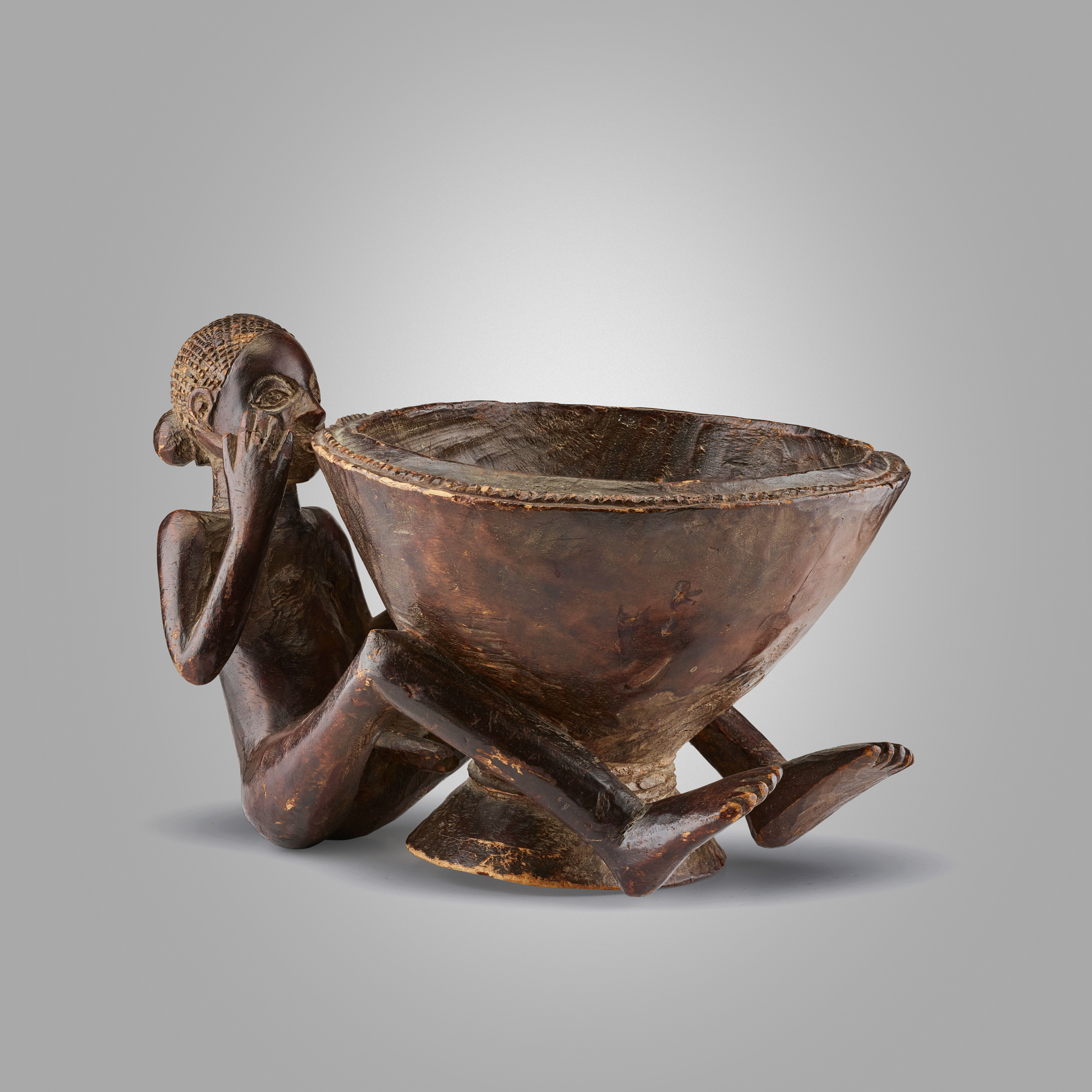KANYOK BOWL ATTRIBUTED TO KADYAAT-KALOOL
DEMOCRATIC REPUBLIC OF CONGO
Estimate: £2,000 - £4,000
Auction: 13 March 2025 from 13:00 GMT
Description
carved wood, the nude male figure is depicted holding the bowl between the legs, with the feet projecting forward and the knees bent, the right hand expressively touches the face, while the left hand also holds the bowl, with the arm following the position of the torso, rich patination
Dimensions
26.2cm diameter
Provenance
Private collection, France
Loudmer-Poulain, Paris, Arts Primitifs, 19–20 June 1980, lot 316
Collection Morton Dimondstein (1920–2000), Los Angeles
Collection John Rich (1925–2012), Beverly Hills
Joshua Dimondstein, Los Angeles
Footnote
The present Kanyok seated bowl bearer (kabila mboko) can be confidently attributed to the master carver Kadyaat-Kalool (d. 1920). Kalool served as the manindak, or master wood sculptor, at the court of Chief Kabw-Mukalang in Kanda-Kanda, a colonial administrative post situated on the northern outskirts of the Kanyok Kingdom, within the borders of what is now the Democratic Republic of the Congo. Operating within the diverse and multicultural environment of Kanda-Kanda, Kalool developed a distinctive artistic style that merged traditional Kanyok aesthetics with influences from neighbouring cultures. This unique blend reflects the interaction between local traditions and broader regional dynamics.
Kalool’s works are renowned for their naturalistic portrayal of human interactions and expressive poses, often capturing intimate or everyday moments. The present seated bowl bearer exemplifies Kalool's artistic mastery, with a striking depiction of the human form. Notably, one hand is delicately placed to the face, adding a distinctive and engaging element to the piece. This work may well be the only known example of a bowl executed by Kalool in this unique manner. It can be compared to other examples attributed to Kadyaat, such as those in the Ethnologisches Museum in Berlin collected by Frobenius in 1904, (accession number IC 23091) and the Royal Museum for Central Africa in Tervuren (acquired before 1918, accession number EO 1948.31).
Kalool’s style is emblematic of the Kanda-Kanda workshop, a tradition that has garnered increasing scholarly attention in recent years. In November 2006, Sotheby’s New York auctioned a rare couple from the Kanda-Kanda workshop, part of the William Brill collection, for $273,000. It has been suggested that the present piece stands out as the most sophisticated and is closest in style to the couple from the former Brill collection.
First identified and described by Frans Olbrechts (who considered Kanyok artworks as a regional manifestation of the Luba style), the earliest first-hand 19th-century information on Kanyok art comes from the Michaux expedition (February -August 1896), which passed through Kanyok territory. While the expedition members stayed in Kanda-Kanda for four days, they did not acquire any pieces in the distinctive Kanda-Kanda style. However, in 1902, the Tervuren Museum received its first artefact in this style, a sculpted folding chair sent by Alexandre Pimpurniaux, a colonial administrator. This acquisition helped establish a clearer timeline for the emergence of the Kanda-Kanda style, which is believed to have developed between 1896 and 1902. However, the identity of Kadyaat-Kalool himself was revealed long after his death through field research conducted by Rik Ceyssens in 1985 in the northern region of the Kanyok territory.
Kalool’s legacy, shaped by his significant contributions to the Kanda-Kanda style, continues to be celebrated today. His works are housed in prestigious collections worldwide, including the Museum aan de Stroom in Antwerp and the Musée Barbier-Mueller in Geneva.

